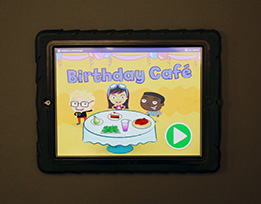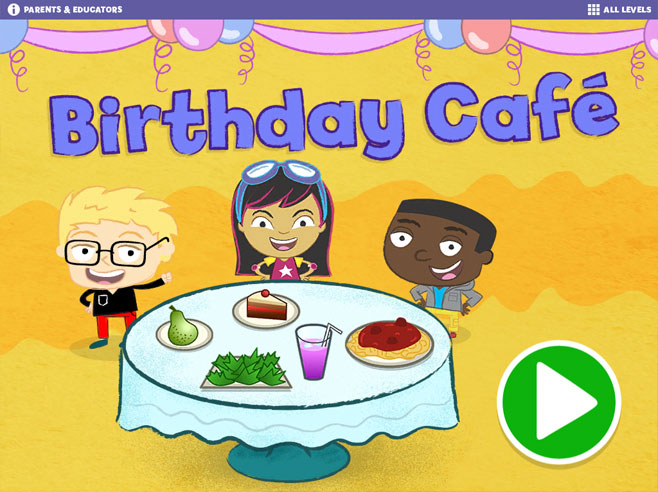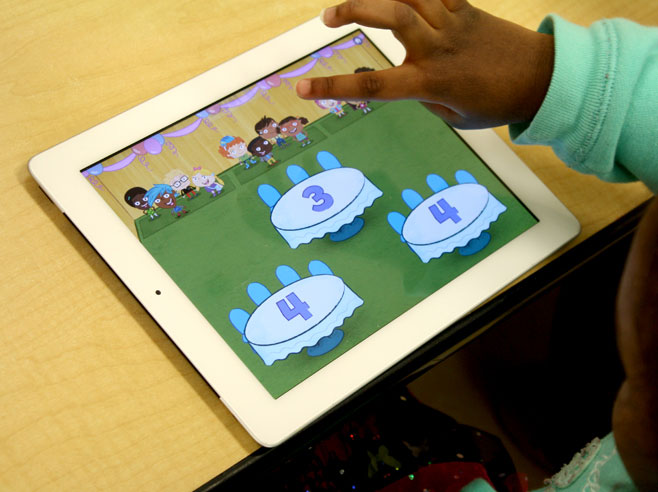Children seat the correct number of people at each table and then make sure that everyone gets the same amount of food to eat.
Materials

- Birthday Café digital game on the iPad
Preparation
- Make sure the iPads are adequately charged and Birthday Café is installed.
Directions
- Start with one iPad (keep any additional iPads out of reach).
- Introduce the game. Tell the children they are going to play a game called Birthday Café on an iPad. Tell them that everyone will get a chance to play. Explain that the object of the game is to seat groups of friends at tables with the correct number of chairs.
- Demonstrate how to play the game. Talk the children through the training level at the beginning of the game. In the animated tutorial, Leo shows how to seat Gracie at a table with one chair. After watching Leo’s demonstration, have a child demonstrate how to seat Gracie at the table. Then have him or her drag some food off the conveyor belt at the bottom of the screen to give to Gracie.
- Tap the green arrow and demonstrate Level 1 to the children. Try placing a group of friends at a table with an incorrect number of chairs. Ask the children: What happened? (The game would not let you seat the friends at this table.) Ask, What did the game say was the reason they couldn’t seat the friends at this table? (Too many or not enough chairs.) Point out the numbers on the tables so that children become familiar with these as well. Have a child demonstrate how to place the groups of friends at the correct tables. Ask, How can we be sure the correct number of friends are seated at the tables? (Count.)
- Then show to how to distribute trays with the correct number of food items to the tables.
- Distribute any additional iPads and invite children to play the game. Be available throughout game play. Allow children to play on their own or with a partner while you observe and engage them in conversations about the math. Choose moments to interact that do not interrupt game play, such as at the start of a new level, or when a child is struggling and is open to assistance.
- Promote math talk and learning:
- Have children call out the number of people in a group, the number of food items on a tray, or the number on the table.
- To get children to communicate verbally and logically about the math task and their thinking, ask questions such as: Why did you do that? How do you get to the next level? What if there were four people at this table instead of three? What would you do?
- As the game advances, the levels become more difficult, with more friends and food to share. Assist children having problems with the math, especially as the equal sharing becomes more difficult. Reassure children that it’s okay if the game feels hard. It will get easier as they practice. Here are some typical problems children experience and some suggested solutions:
- If a child is unsure of where to seat people, have him or her count the number of people in the group and then count the number of chairs at the tables until the numbers match. Reinforce by counting all of the people again once they are sitting in the chairs.
- If a child is having trouble with timing (when to drag trays and distribute food), focusing on only one table at a time can help. Have the child first identify the correct group tray of foods for a specific table first, and then add the task of distributing the trays to the table.
- If a child is overwhelmed by the number of screen tasks, simplify. Have the child focus on just one table, preferably the table with the fewest number of people. Then instruct the child to watch the conveyor belt for a tray that has the correct number of food items.
- If a child is struggling to find the correct number of snacks for a given table, select trays from the conveyor belt and hold them near the table in question. Ask the child: Does this tray have one item for everyone at the table? Guide the child to count the items on the tray, if needed, and explain whether there are too few, too many, or just the right amount.
- If a child is still having trouble with either the math or the motor skills necessary to play the game, consider having the child play Jungle Gym, which allows for slower, self-paced play. A child could also play Treasure Bubble with a more advanced partner who can help.
- Assist children as needed with the mechanics of game play, but keep the main focus on math talk.
- If a child is having difficulty dragging groups of people or trays of food across the screen, instruct the child to use a light touch. The child must tap the object with a finger and hold the finger on that object to drag it.
- Children learn from and teach each other — especially when they’re playing! Encourage simultaneous or collaborative play for struggling children. Invite more advanced children to explain how they make fair shares with the different foods.
- Overall, have fun and allow the children to have fun too. They’ll learn while playing!

